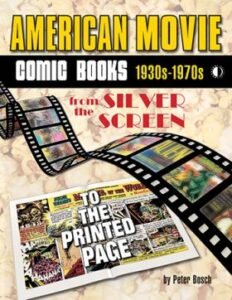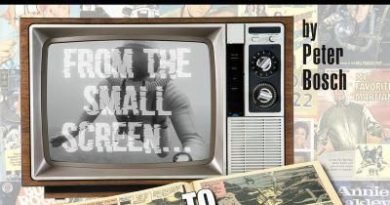American Movie Comic Books: 1930s-1970s From The Silver Screen To The Printed Page by Peter Bosch (book review).
Writer Peter Bosch explains in his introduction that ‘American Movie Comic Books: 1930s-1970s ‘From The Silver Screen To The Printed Page’ is a direct sequel to his earlier book, ‘American TV Comic Books: 1940s-1980s’. Be careful with the name titles because they look awfully close enough to confuse the Long River website AI if it cuts the title down.
The film industry studios saw comic books as just one of their means for promoting their films and cast when they were allowed to use their likenesses. It also, as with Charlie Chaplin, kept them in the public eye between films. Bosch doesn’t say whether the reading audience was targeting the young, adults or both.
The first full comic book adaptation came about and was based on the 1933 film Police Car 17 by Whitman. Also, don’t think second-rate artists got involved in this time in the comic book business, as the likes of Will Eisner, Jack Kirby, Frank Frazetta, Steve Ditko, Alex Toth, John Buscema, Dick Giordano, Neal Adams, George Perez, Gene Colan and Dan Spiegel, among others, also worked here, and some were very prolific. Indeed, there are profiles of many of the significant artists included in this book. There is some mention of some UK film adaptations, but we never developed them much over here at the time.
When it reached the 1950s, you would have thought significant SF films like ‘Forbidden Planet’, ‘This Island Earth’ or even ‘Them’ might have been adapted, but, obviously, the film publicists didn’t think it was worthwhile. There were about half a dozen SF/fantasy films that were adapted, so it is clear that the genre was not considered taboo.
Although Bosch points out where there are restrictions on using some actors’ likenesses, he doesn’t cover any lead-in time between a comic book being drawn and released if known. The limited availability of stills and the infrequent viewings of the film restrict what can be illustrated. Knowing the difference must help. Frazetta’s depiction of Burt Lancaster with blonde hair, something he never did in his films, still puzzles me.
The 1960s really exploded with film adaptations, not just in comic books but also in some photo layouts. You would have thought those might have caught on more, but I suspect the time it took to select the right frame probably added to the expense. It wasn’t only the domain of Disney and general release films; science fiction, fantasy, and horror films were also developing a wider selection.
Although I’m reading this book all the way through, I suspect it should really be treated as a reference book. As such, it could have done with a proper index, but if you know the date of the film’s release, it’s easy to locate. However, it becomes tricky to categorise films like ‘The Wizard Of Oz’ and ‘2001: A Space Odyssey’ since they were adapted in the 1970s.
Ironically, the one film from this period that should have had a comic book adaptation is the 1966 ‘Batman’, but it never received one. Then again, the first Christopher Reeve film, ‘Superman’, also did not receive a comic book adaptation. Logistically, Warner probably thought they already had that fan audience and did not need to reinforce it, forgetting that a comic book adaptation might have attracted more readers who were not already fans.
With the 1980s, Bosch says he only picked examples, but beyond that point, films could be bought on video or later DVD and haven’t really needed comic book adaptations. I did ponder if he missed anything. Certainly ‘2010: The Year We Made Contact’ isn’t noted for any of ‘The Terminator’, ‘Predator’ or ‘Alien’ (beyond the first film) franchises. If anything, it’s a demonstration of how film promotion is moving on in the modern age.
I think if you’re a comic book artist fan and after every last thing they’ve done, like, for example, Frazetta or Buscema, then this book is an asset for their early work. The same if you’re interested in Disney’s early animated films made into comics because they use accurate pictures; then you’ll know what you’re looking for. There are also a lot of art samples of covers and interiors and a useful reference guide. I’ve seen a lot of the films that were adapted, and probably the most notable exception is the animated 1962 film ‘Gay Purr-ee’, added to my list to have a look at.
Part of my job as a reviewer is to look for flaws in the books I read. Although I’ve focused on some above, there really aren’t that many, and I suspect you’ll be racking your brains for anything missed as you read the book. I learnt a lot here, and I was surprised Disney didn’t create its own comic books to release their own adaptations. You’ll probably have other observations. There hasn’t been a book in this area of comics before, and it’s probably overlooked by comic book fans. Given the contributions of numerous esteemed artists, we should not undervalue this field.
GF Willmetts
October 2025
(pub: TwoMorrows Publishing. 191 page illustrated softcover. Price: $34.95 (US). ISBN: 978-1-60549-129-2. Direct from them, you can get it for $34.95 (US)).
check out websites: www.TwoMorrows.com and https://twomorrows.com/index.php?main_page=product_info&cPath=95_96&products_id=1857




